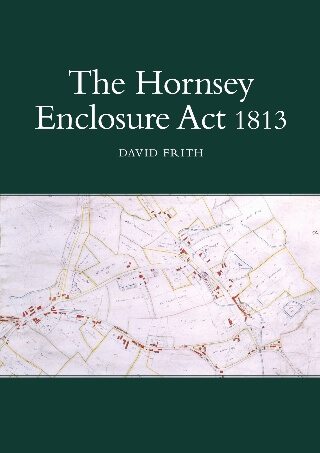This fascinating and well researched book examines the detailed provisions of the Hornsey Enclosure Act of 1813 and their effect on the subsequent development of the ancient Parish of Hornsey.

The book contains a much scaled down Enclosure Map. There are also maps of Hornsey Common, Highgate or Southwood Common and Muswell Hill Common as well as an Index of Land Allocations.
Book details
Paperback: 92 pages
Publisher: HHS (2021)
ISBN: 978-0-906794-57-9
RRP: £12.00
We aim to send out all items within 5-7 days, but as a small Society run entirely by volunteers turnaround times may sometimes vary.
From the book
Enclosure Acts were private Acts of Parliament, usually instituted by the Lord of the Manor and related to a particular manor or parish. Their purpose was to enclose, divide and allot to individual tenants or freeholders the commons and waste lands of the manor that had by custom previously been used by all the residents of the manor who had rights of grazing and collecting fuel etc or, in the case of open field systems, the right of arable cultivation. These Acts appointed commissioners who had almost dictatorial powers to enclose commons, waste lands and open field systems, divide and allot the land, stop up, divert or create new roads, carry out drainage and a number of other functions.
In many rural parishes where the open field strip system was in operation the landscape was changed beyond all recognition with the creation of smaller enclosed fields, realigned roads and scattered farm houses in place of the traditional grouping of houses within a village. This is the pattern that largely persisted until the post-1945 movement for large-scale industrialised farming in arable areas.
The impetus for enclosure was part of the movement for improved agricultural methods, fuelled in part by population increases which meant an increased demand for food. It also, in enabling land owners to increase the productivity of their land, increased its value. There had always been enclosures and in some areas of the country particularly in the south-east, fields were enclosed from the time of the initial clearance of the forests and common land was rare.
In Tudor times Acts restricting enclosure were passed out of concern that enclosures in certain areas were leading to the depopulation of villages when arable farmland was enclosed for sheep production. Up to about 1730 most enclosures were dealt with by private agreements between the owners of the land in question, or more likely by the Lord of the Manor exercising his will over his tenants.
The enclosure movement changed the face of England. Not only did it change the face of the country, but it also changed the way in which many people lived and the way in which the land was farmed. There has long been debate about its true effects, but it is generally accepted that it increased the amount of land in the hands of the upper and wealthy classes and allowed the more enterprising small freeholders to become larger farmers. The weaker and poorer men sank into the status of labourers at a time when, owing to the increase in the rural population, there was already a drift of the labouring classes into the towns.
About the author
David Frith was a town planner by profession and has lived in Muswell Hill since 1966. He was appointed as the first Borough Planning Officer to the new London Borough of Haringey on its inception in 1965 and held the post for 22 years. He is Vice Chairman of HHS, a member of the General and Publications Committees and he is also the society’s Conservation Officer.